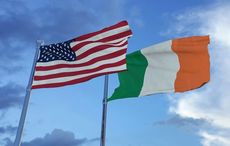Excerpted from Echoes of Their Footsteps Volume II The Irish Civil War by Kathleen Hegarty Thorne
Dateline: 27 June 1920, Jullundur military outpost in India, located three days rail journey from Bombay. According to the Witness Statement of Joseph Hawes, five men sat down in the canteen to discuss what they knew about Crown Forces in Ireland operating with fixed bayonets, and what they could do about it. The men were Joseph Hawes, C. P. “Paddy” Sweeney, Stephen Lally, William Daly, and Pat Gogarty (pp. 1−2). They decided on a course of action.
Read More: Republican Courts during the Irish War of Independence
The next day, Daly bowed out of this dangerous game, but the four others asked to be placed in the guardroom as a protest of the Black and Tans’ actions in their homeland. This was not to be a riotous mutiny, but rather a steadfast and passive resistant protest against British policy in Ireland. By the following day, hundreds more had joined in.
On 29 June, against the advice of the Jullundur Mutineers’ committee, two Rangers (William Keenan and Patrick Kelly of Kinnegad) had gone to another post several hundred miles away, Solon, where another detachment of the Rangers was stationed, to explain the reason for the Jullundur protest and to seek support from fellow Irish soldiers. An account published in the 25 March 1925 Sunday Independent claims that the two men travelled by train but, afraid of being stopped by British troops, they arrived near Solon and hid in the woods until nightfall. Managing to evade sentries, they sought out Hut No. 27, then proceeded to give an account of the events at Jullundur. They were arrested shortly thereafter.
The next day, a group meeting was held in the theatre (canteen), and many of the men decided to join their comrades in Jullundur in this protest. James Daly was elected their spokesperson. Negotiations between the British higher-ups and the Rangers took place, all to no avail.
Read More: The unlucky internees during Ireland's WWII "Emergency"
The following day, the two men who had travelled to Solon with news of the mutiny were brought back under guard to Jullundur and placed in the guardhouse. Later, they were transferred to the guardroom of the Royal Field Artillery, about a mile and a half from the Rangers’ barracks.
In Solon, the potential mutineers were convinced by the British officers to turn in their weapons and maintain an air of passive resistance. A confrontation occurred when James Daly and some of his men, about seventy strong, marched to the hut where the arms were stored and demanded their release. Two guards, actually aiming at Daly, opened fire and shot Peter Sears of The Neale, Co. Mayo, who died at their feet. Eugene “John” Egan was wounded in the chest but survived to stand trial. Patrick Smyth of Drogheda, who was not a mutineer but simply walking down to his bungalow farther down the hill, was hit in the head and died instantly. (His relatives were never compensated by the British government, even though he was not a member of the rebellious force.)
All the mutineers from both Jullundur and Solon eventually were taken to Dagshai Prison, “a gaunt, grim, medieval structure of evil reputation,” to await sentencing. Plank beds in a solitary cell and no change of clothes were not much consolation, nor were the black tea and dry bread that they received morning and afternoon. Dinner consisted of heated bully meat.
In late August, the trials began. Of the original fourteen men who had been given a death sentence, James Joseph Daly, age twenty-two, was the only soldier to face a firing squad. Born in Ballymoe, Co. Galway, he lived his short life in Tyrrellspass, Co. Westmeath.
Read More: The IRA's split-second decisions during Ireland's War of Independence
In December, the mutineers were shipped back to England in leg-irons and idled away in the coldness of a variety of British jails. Davis was sent to Peterhead Prison in Scotland, and John Flannery was sent along with thirteen others to Parkhurst on the Isle of Wight. Some of the men who went to Maidstone went on hunger strike and were force-fed in the usual way: strapped down, a tube thrust into the mouth, and gruel poured through a funnel into the tube.
But on 3 January 1923, it was over. Some of the men had already been released in 1922, but today a group of thirty-two freed mutineers landed in Dun Laoghaire. They were awed by the event because they had been given no forewarning of their imminent release (“The Names and Sentences,” Irish Independent, 5 January 1923, p. 5). They were afforded a grand welcome and breakfast at the Shelbourne Hotel in Dublin, but then ignored by the Free State government. Some in the other Connaught Rangers considered them “turncoats,” while others in the IRA considered them pawns of British imperialism for joining the army in the first place. Most of the people in Ireland were so caught up in the harsh events of the day that they had no time to consider anything other than their own survival.
Many of the mutineers fell on hard times. By 1937 “only fourteen had obtained work in the country for which they had made their sacrifice.” Of the Rangers, all hale and hearty men when they were stationed in India, six were now confined to the grave (“Obstacles by Officials,” Irish Press, 25 January 1937, p. 7).
Many of the men, whose life profession was soldiering, lost their major source of income and their British pension rights when they mutinied. When they returned to Ireland after several years of prison deprivation, some were hard-pressed to find other suitable types of work to support themselves and their families. Nine enrolled in the Civic Guards and thirty-six joined the National Army, though only a few made a career out of military service.
In 1924, John Flannery headed the Ex-Connaught Rangers Committee that lobbied for pensions, which were finally granted in 1936. The Connaught Ranger Mutineers Association was formed in 1927, and its focus was repatriation of the remains of Daly, Sears, and Smyth (Correspondence Oliver Fallon, Vice Chair/Researcher, Connaught Rangers Association, 14 February 2013). These two organisations eventually worked together because of their common interests and common fraternal bond of the mutiny experience.
The three men buried in India were brought back to the home sod in 1970. The bodies of Sears and Smyth were laid to rest in Glasnevin, while Daly was returned to his native village of Tyrrellspass, Co. Westmeath. Relatives of John Miranda could not be found to grant their permission for a transfer. His remains lie still in Kirkee 1914−1918 Memorial Cemetery.
And thus another chapter of Irish resistance to English occupation came to a close. Men in the British Army who had risked it all by their protest did not receive earthly rewards for their efforts. Many found only a hard row to hoe throughout their lifetimes.
A complete listing of the Connaught Rangers involved in the protest was compiled through the efforts of Patrick Flanagan of Ballinvegga, Enniscorthy, Co. Wexford, formerly of Cornashinagh, Four Mile House, Co. Roscommon, and Oliver Fallon, Vice Chair/Researcher of the Connaught Ranger Association, both of whom graciously shared their research with this author.
Read More: Sergeant John Duffy: An unlikely comrade during the Irish War of Independence
This article was submitted to the IrishCentral contributors network by a member of the global Irish community. To become an IrishCentral contributor click here.




Comments